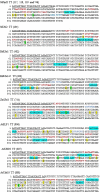Transcription Terminator-Mediated Enhancement in Transgene Expression in Maize: Preponderance of the AUGAAU Motif Overlapping With Poly(A) Signals
- PMID: 33178242
- PMCID: PMC7591816
- DOI: 10.3389/fpls.2020.570778
Transcription Terminator-Mediated Enhancement in Transgene Expression in Maize: Preponderance of the AUGAAU Motif Overlapping With Poly(A) Signals
Abstract
The selection of transcription terminators (TTs) for pairing with high expressing constitutive promoters in chimeric constructs is crucial to deliver optimal transgene expression in plants. In this study, the use of the native combinations of four polyubiquitin gene promoters and corresponding TTs resulted in up to >3-fold increase in transgene expression in maize. Of the eight polyubiquitin promoter and TT regulatory elements utilized, seven were novel and identified from the polyubiquitin genes of Brachypodium distachyon, Setaria italica, and Zea mays. Furthermore, gene expression driven by the Cassava mosaic virus promoter was studied by pairing the promoter with distinct TTs derived from the high expressing genes of Arabidopsis. Of the three TTs studied, the polyubiquitin10 gene TT produced the highest transgene expression in maize. Polyadenylation patterns and mRNA abundance from eight distinct TTs were analyzed using 3'-RACE and next-generation sequencing. The results exhibited one to three unique polyadenylation sites in the TTs. The poly(A) site patterns for the StPinII TT were consistent when the same TT was deployed in chimeric constructs irrespective of the reporter gene and promoter used. Distal to the poly(A) sites, putative polyadenylation signals were identified in the near-upstream regions of the TTs based on previously reported mutagenesis and bioinformatics studies in rice and Arabidopsis. The putative polyadenylation signals were 9 to 11 nucleotides in length. Six of the eight TTs contained the putative polyadenylation signals that were overlaps of either canonical AAUAAA or AAUAAA-like polyadenylation signals and AUGAAU, a top-ranking-hexamer of rice and Arabidopsis gene near-upstream regions. Three of the polyubiquitin gene TTs contained the identical 9-nucleotide overlap, AUGAAUAAG, underscoring the functional significance of such overlaps in mRNA 3' end processing. In addition to identifying new combinations of regulatory elements for high constitutive trait gene expression in maize, this study demonstrated the importance of TTs for optimizing gene expression in plants. Learning from this study could be applied to other dicotyledonous and monocotyledonous plant species for transgene expression. Research on TTs is not limited to transgene expression but could be extended to the introduction of appropriate mutations into TTs via genome editing, paving the way for expression modulation of endogenous genes.
Keywords: Poly(A) signals; gene silencing; maize; polyadenylation sites; polyubiquitin gene promoter; transcription terminator; transgene expression.
Copyright © 2020 Wang, Kumar, Zeng, McEwan, Wright and Gupta.
Figures




Similar articles
-
Revealing frequent alternative polyadenylation and widespread low-level transcription read-through of novel plant transcription terminators.Plant Biotechnol J. 2010 Sep;8(7):772-82. doi: 10.1111/j.1467-7652.2010.00504.x. Epub 2010 Mar 16. Plant Biotechnol J. 2010. PMID: 20331530
-
Arabidopsis and maize terminator strength is determined by GC content, polyadenylation motifs and cleavage probability.Nat Commun. 2024 Jul 12;15(1):5868. doi: 10.1038/s41467-024-50174-7. Nat Commun. 2024. PMID: 38997252 Free PMC article.
-
Brachypodium distachyon promoters as efficient building blocks for transgenic research in maize.J Exp Bot. 2012 Jun;63(11):4263-73. doi: 10.1093/jxb/ers113. Epub 2012 Apr 20. J Exp Bot. 2012. PMID: 22523343
-
Alternative polyadenylation and gene expression regulation in plants.Wiley Interdiscip Rev RNA. 2011 May-Jun;2(3):445-58. doi: 10.1002/wrna.59. Epub 2010 Nov 9. Wiley Interdiscip Rev RNA. 2011. PMID: 21957029 Review.
-
Implications of polyadenylation in health and disease.Nucleus. 2014;5(6):508-19. doi: 10.4161/nucl.36360. Epub 2014 Oct 31. Nucleus. 2014. PMID: 25484187 Free PMC article. Review.
Cited by
-
Transcriptional and post-transcriptional controls for tuning gene expression in plants.Curr Opin Plant Biol. 2023 Feb;71:102315. doi: 10.1016/j.pbi.2022.102315. Epub 2022 Nov 30. Curr Opin Plant Biol. 2023. PMID: 36462457 Free PMC article. Review.
-
Building a pipeline to identify and engineer constitutive and repressible promoters.Quant Plant Biol. 2023 Oct 19;4:e12. doi: 10.1017/qpb.2023.10. eCollection 2023. Quant Plant Biol. 2023. PMID: 37901686 Free PMC article.
-
Tunable control of insect pheromone biosynthesis in Nicotiana benthamiana.Plant Biotechnol J. 2023 Jul;21(7):1440-1453. doi: 10.1111/pbi.14048. Epub 2023 Apr 9. Plant Biotechnol J. 2023. PMID: 37032497 Free PMC article.
-
Plant terminators: the unsung heroes of gene expression.J Exp Bot. 2023 Apr 9;74(7):2239-2250. doi: 10.1093/jxb/erac467. J Exp Bot. 2023. PMID: 36477559 Free PMC article. Review.
-
Arabidopsis and Maize Terminator Strength is Determined by GC Content, Polyadenylation Motifs and Cleavage Probability.bioRxiv [Preprint]. 2024 Jan 8:2023.06.16.545379. doi: 10.1101/2023.06.16.545379. bioRxiv. 2024. Update in: Nat Commun. 2024 Jul 12;15(1):5868. doi: 10.1038/s41467-024-50174-7. PMID: 37398426 Free PMC article. Updated. Preprint.
References
-
- Abendroth L., Elmore R., Hartzler R. G., McGrath C., Mueller D. S., Munkvold G. P., et al. (2009). Corn field guide. Iowa State University, Ames, IA: Extension and Outreach Publications.
LinkOut - more resources
Full Text Sources
Other Literature Sources

